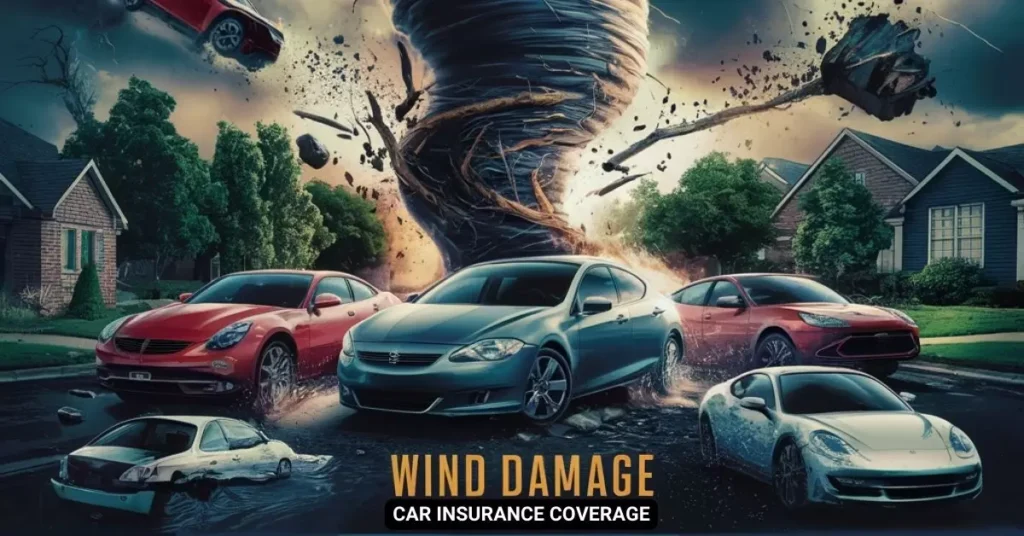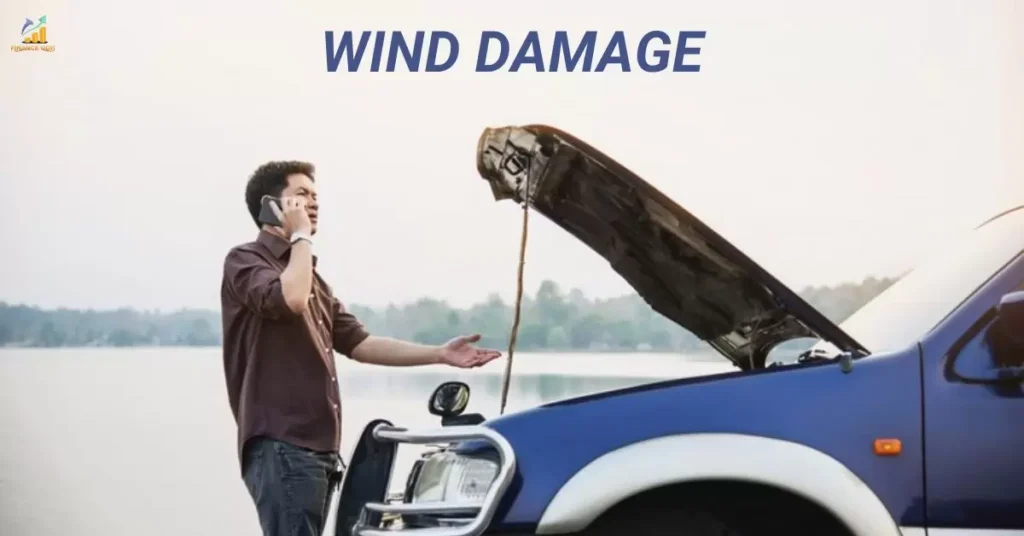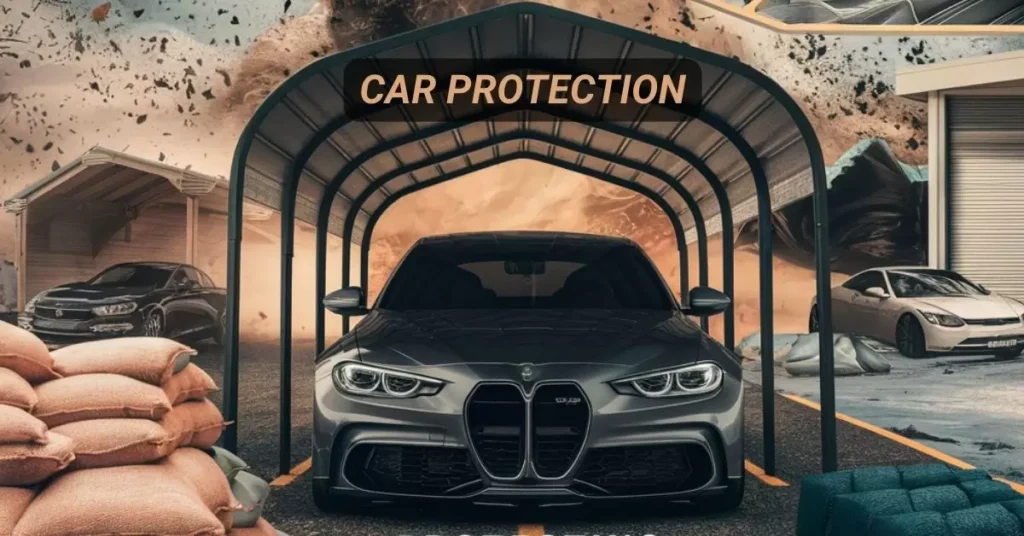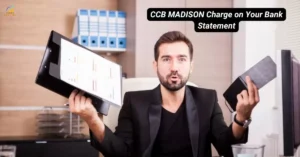When Mother Nature unleashes her fury, your car might find itself in the crosshairs of powerful winds. Picture this: you’re peacefully sleeping through a stormy night, only to wake up and find a massive tree branch has turned your car’s roof into a makeshift sunroof. At that moment, you’re left wondering, Does my car insurance cover wind damage? It’s a question that can leave even the most seasoned drivers scratching their heads.
Wind damage to vehicles is more common than you might think. The aftermath of a windstorm is destructive and expensive, caused by airborne particles or fallen trees. Therefore, it is important to comprehend your insurance policy. To help you with car insurance coverage as well as filing claims for wind damage, this guide will provide you with everything that you need to know.
Types of Car Insurance That May Cover Wind Damage
Not every type of insurance is similar when it comes to shielding the car against the unpredictability of the wind. The following are some categories of coverage that could aid when there’s an air gust.
Comprehensive Coverage: Your Wind Damage Safety Net
In terms of wind destruction, comprehensive insurance can be considered as a hero who saves cars from damages caused by wind. This particular coverage is meant for protecting the cars against non-collision related occurrences such as:
- Falling objects (like those pesky tree branches)
- Natural disasters
- Theft
- Vandalism
When it comes to wind damage, comprehensive coverage is your best friend. It’s the policy that’s most likely to have your back when a guest decides to redecorate your car with the neighbor’s lawn furniture.
Pro Tip: In the majority of states, comprehensive coverage is not a legal requirement, but still, it is sometimes better worth investing your money on it, especially if you live in regions where bad weather happens frequently.
Other Relevant Coverage Types
While comprehensive coverage is the star player in the wind damage game, there are other types of insurance that might come into play:
- Collision Insurance: This usually includes damages from unforeseen events; however, if strong winds cause you to lose control and hit something else, it can also be applicable.
- Personal Property Coverage: This isn’t part of your auto policy, but rather your homeowners or renters insurance. It might cover items inside your car that are damaged by wind
Remember, customized insurance policies may vary according to what their holders want. So reading through insurance documents or making an inquiry to an agent would suffice in showing you what is actually included in the cover.
Does Car Insurance Cover Tornado Damage?
Usually, car losses arising from tornado disasters are covered under a comprehensive insurance policy. This coverage shields you from losses that are caused by natural disasters. Most standard auto insurance packages comprise comprehensive coverage.

Deductibles for tornado damage can vary. Some insurers may have special deductibles for severe weather events.
The new reports indicate that tornado occurrences have increased in some areas. Hence, it is necessary to persistently assess your policy for sufficient cover.
Common Wind Damage Scenarios and Insurance Coverage

Wind can wreak havoc on your vehicle in various ways. Let’s explore some common scenarios and how insurance typically handles them.
Falling Objects: When Gravity and Wind Conspire
When objects decide to use your car as a landing pad, one of the most frequent types of wind-related damage occurs. Here’s what you need to know:
- Trees and Branches: Comprehensive coverage generally comes into play if a tree or branch falls on your vehicle due to wind. It applies whether you’re home in your driveway or driving.
- Other Debris: Usually, comprehensive coverage applies to everything from roof shingles to outdoor chairs, if the wind blows it away into your vehicle.
Case Study: The blow of a windstorm in 2020 caused losses which went beyond $1 billion, as per inscriptions on papers by the Ohio Department of Insurance. Most of the insured losses were losses that arose from falling trees and other objects hitting cars. Therefore, the need for comprehensive cover is important in such windy places.
Flying Debris: The Airborne Menace
Sometimes, the wind doesn’t just drop things on your car; it hurls them at it. Here’s how insurance typically handles these scenarios:
- Gravel and Small Objects: When a rock hits your car and breaks its paint or windshield due to being thrown by the wind, usually, the comprehensive coverage takes care of it.
- Larger Debris: Generally speaking, damages arising due to wind propelled objects either trash can flying or trampoline runaway are all included in the comprehensive cover.
Wind-Related Accidents: When Gusts Lead to Crashes
When it’s windy, you may lose control of your car which can result in accidents. Here’s what you need to know:
- Usually, collision coverage applies when the wind makes you lose control of your vehicle and hit another car or object.
- If high winds flip your car, comprehensive coverage usually covers the damage.
Important: Your safety should always come first. In the event that there is strong wind that affects your driving, it would be best if you stayed off the road at all times.
Related Article: Does Your Car Insurance Cover Mice Damage? Find Out Now!
Factors Affecting Wind Damage Coverage
However, several factors can influence claims for wind damage despite having the appropriate insurance. Let’s dive into the details.
Policy Specifics: The Devil’s in the Details
When it comes to insurance, the fine print matters. Here are some policy-specific factors that can affect your wind damage coverage:
- Deductibles: This is the amount you’ll pay out of pocket before your insurance kicks in. For example:
| Deductible | You Pay | Insurance Pays (on a $2000 claim) |
| $250 | $250 | $1750 |
| $500 | $500 | $1500 |
| $1000 | $1000 | $1000 |
- Coverage Limits: Here is the highest amount that your insurance company can pay for any claims made. It is essential for you to make sure that the limits of your coverage are sufficient enough to provide appropriate care for your vehicle.
- Policy Exclusions: Certain types of wind damage may have specific exclusions in some policies. So as to understand what is not catered for, you should read your policy carefully.
Severity of Damage: From Dings to Disasters
The extent of wind damage can range from minor cosmetic issues to total vehicle loss. Here’s how severity typically affects coverage:
- Minor Damage: Your deduction might not cover little scrapes of paint or small indentation which requires self-financing.
- Moderate Damage: Your deductible doesn’t come into play when dealing with matters like cracked windshields or surefire multiple dents, for instance.
- Major Damage: Severe structural damage or a totaled vehicle will typically be covered up to your policy limits.
“The severity of wind damage can greatly impact how a claim is processed. While minor scratches might not warrant a claim, significant structural damage could lead to your vehicle being declared a total loss.” – Jane Doe, Senior Claims Adjuster at XYZ Insurance
Geographic Location: Where You Live Matters
Your location can significantly impact both your risk of wind damage and your insurance coverage:
- High-Risk Areas: Having a house located within the hurricane, tornado or severe windstorm-prone areas could mean that you will spend more in paying for premiums or even experience special deductibles relating to wind damages.
- Urban vs. Rural: Urban spaces might experience a greater propensity for harm due to debris borne by winds, while rural regions may encounter increased levels of destruction because of trees that have fallen.
Fact: According to the National Weather Service, in 2021, there were over 1,000 tornadoes reported in the United States, with the highest concentration in “Tornado Alley” – a region including Texas, Oklahoma, Kansas, and Nebraska.
Steps to Take When Your Car Suffers Wind Damage

Having knowledge on how to manage windsoll damage to your automobile may help you a lot in terms of your money and peace of mind. This is what you do when winds blow too hard and cause harm to your vehicle.
Immediate Actions: Safety First, Document Second
- Ensure Safety:
- Look for any wounds on you or your fellow riders.
- In case there is a perilous area where your automobile is parked, try to safely relocate it to another place within reach.
- Be aware of potential hazards like downed power lines or unstable structures.
- Document the Damage:
- Take extensive photos and videos of the damage from multiple angles.
- Note the date, time, and weather conditions when the damage occurred.
- If there were witnesses, get their contact information.
- Prevent Further Damage:
- If there’s a broken window or damaged roof, cover it with a tarp to prevent water damage.
- Remove valuable items from the car if it’s not secure.
Contacting Your Insurance Provider: Navigate the Claims Maze
Once you’re safe and have documented the damage, it’s time to get the claims process rolling:
- Report the Incident:
- Contact your insurance company as soon as possible.
- Provide all the details you’ve gathered about the damage.
- Ask about your coverage and what to expect from the claims process.
- Understanding the Claims Process:
- Get clarity on your deductible and how it applies to your claim.
- Ask about the timeline for processing your claim.
- Inquire about rental car coverage if your vehicle is not drivable.
Pro Tip: Documentation of every communication made with your insurance company is important. Keep all dates, times and names of representatives you have a conversation with.
Related Article: Does Your Car Insurance Cover Water Damage? Learn the Facts
Getting Repairs: From Assessment to Restoration
Once your claim is in motion, it’s time to focus on getting your car back in shape:
- Choosing a Repair Shop:
- Ask your insurance company if they have preferred repair shops.
- You typically have the right to choose your own repair shop, but using a preferred shop might streamline the process.
- Get estimates from multiple reputable shops if possible.
- Working with Insurance Adjusters:
- An adjuster will likely inspect your vehicle to assess the damage.
- Be present during the inspection if possible to point out all areas of damage.
- Don’t agree to repairs until you’re satisfied with the assessment and proposed solution.
- Monitoring the Repair Process:
- Stay in touch with both the repair shop and your insurance company.
- Don’t be afraid to ask questions about the repairs being done.
- Before accepting the repaired vehicle, inspect it thoroughly to ensure all damage has been addressed.
Case Study: John’s automobile experienced serious destruction due to a palm tree that fell on it after a violent hurricane in Florida. It was through good documentation of the damage, making an early report to his insurer, and being deeply involved in making claims that he got the car completely repaired at very low personal costs although at first the insurance company resisted some claims for damages made by him.
Tips for Protecting Your Car from Wind Damage

Light rains or strong winds can make it difficult to control a vehicle but there are ways to lessen the risk associated with wind damage. Here are some precautions against strong winds and factors about insurance to note.
Preventive Measures: An Ounce of Prevention
- Smart Parking Strategies:
- When possible, park in a garage or covered area during severe weather.
- If outdoor parking is unavoidable, choose spots away from trees, power lines, and structures that could collapse.
- In high-wind situations, try to park with your car’s rear facing the wind to minimize damage to the windshield.
- Regular Maintenance:
- Keep your car in good condition. Well-maintained vehicles are less likely to suffer additional damage from flying debris.
- Regularly check and replace windshield wipers to ensure clear visibility during storms.
- Consider applying a protective film to your car’s paint to guard against minor scratches from wind-blown debris.
- Weather Awareness:
- Stay informed about weather forecasts, especially during storm seasons.
- If severe winds are predicted, consider relocating your vehicle to a safer location if possible.
Additional Insurance Considerations: Fortify Your Financial Protection
- Reviewing Your Policy:
- Regularly review your car insurance policy to ensure you have adequate coverage.
- Pay attention to any changes in your policy during renewals.
- Consider increasing your comprehensive coverage if you live in an area prone to severe weather.
- Considering Additional Coverage:
- Gap insurance can be valuable if you owe more on your car than its actual cash value.
- Rental car coverage can be a lifesaver if your vehicle is out of commission due to wind damage.
- Documenting Your Vehicle:
- Keep an up-to-date inventory of any valuable items you regularly keep in your car.
- Take periodic photos of your vehicle to have a record of its condition before any damage occurs.
Fact: The Insurance Information Institute reported that comprehensive claims in which wind damage is included constitute nearly 35% of total auto insurance claims within the US.
Frequently Asked Questions
Will my rates go up if I file a wind damage claim?
Filing a comprehensive claim for wind damage typically has less impact on your rates than an at-fault collision claim. However, multiple claims in a short period might lead to increased premiums. It’s always best to discuss potential rate impacts with your insurance provider before filing a claim.
What if wind damage totals my car?
When the expense of fixing wind damage surpasses a given percentage of your automobile’s worth (usually approximately 75%), then insurance enterprises might consider it as a full loss. Henceforth, you can get paid for how much your car is really worth less your deductibles.
Does car insurance cover damage from hurricanes or tornadoes?
Yes, comprehensive coverage typically includes damage from severe weather events like hurricanes and tornadoes. However, in some high-risk areas, there might be special deductibles or limitations for these types of events, so it’s crucial to understand your policy details.
Final Thoughts
This is especially essential if one’s abode is situated in a region with harsh climatic conditions. Here’s a quick recap of the key points:
- If you want to protect yourself from wind damage, then comprehensive coverage is the way to go.
- The specifics of your policy, including deductibles and coverage limits, greatly affect your protection.
- Prompt action and thorough documentation are essential when dealing with wind damage.
- Preventive measures can help minimize the risk of wind damage to your vehicle.
It is a combination of enough insurance coverage together with proactive protection measures that serves as a strong defense against the financial impact of wind damage. Therefore, always take time to go through your policy and know the kind of coverage you have and also prepare your vehicle for anything that nature may throw at it.
Don’t wait for the next big storm to hit. Review your car insurance policy today and ensure you’re properly covered for wind damage. After all, when it comes to protecting your vehicle, it’s better to be safe than sorry.

I write professional blogs specializing in car insurance. My content delves into various aspects of insurance policies, providing valuable insights and tips for choosing the best coverage. My goal is to make complex insurance topics accessible and engaging for all readers.











